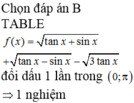Giải phương trình sau: tanx + tan (x+π/4) = 1

Những câu hỏi liên quan
giải các phương trình sau
a/ \(^{tan^2x-\frac{4}{cotx}+=0}\)
b/\(cos2\left(x+\frac{\text{π}}{3}\right)+4cos\left(\frac{\text{π}}{6}-x\right)=\frac{5}{2}\)
c/\(\frac{1}{cos^2x}-1+tanx-\sqrt{3}\left(tanx+1\right)=0\)
d/tanx-2cotx+1=0
Mọi người ơi giúp mình với <3 cảm ơn mọi người nhìu ạ
Bạn ghi đề chính xác ra đi, câu a và câu b đó bạn
Câu a sau \(\frac{4}{cotx}\) còn dấu + nhưng không biết cộng với cái gì
Câu b biểu thức cos đầu tiên là \(cos^2\left(x+\frac{\pi}{3}\right)\) hay \(cos\left(2x+\frac{2\pi}{3}\right)\)
Đúng 0
Bình luận (0)
a) Đề thiếu
b)
PT $\Leftrightarrow 1-2\sin^2(x+\frac{\pi}{3})+4\cos (\frac{\pi}{6}-x)-\frac{5}{2}=0$
$\Leftrightarrow 1-2\sin ^2[\frac{\pi}{2}-(\frac{\pi}{6}-x)]+4\cos (\frac{\pi}{6}-x)-\frac{5}{2}=0$
$\Leftrightarrow -2\cos ^2(\frac{\pi}{6}-x)+4\cos (\frac{\pi}{6}-x)-\frac{3}{2}=0$
$\Leftrightarrow -2t^2+4t-\frac{3}{2}=0$ với $t=\cos (\frac{\pi}{6}-x)$
Đến đây bạn giải pt bậc 2 thu được $\cos (\frac{\pi}{6}-x)=\frac{1}{2}$
$\Rightarrow x=2k\pi +\frac{\pi}{2}$ hoặc $x=2k\pi -\frac{\pi}{6}$ với $k$ nguyên
Đúng 0
Bình luận (0)
c)
ĐK:.............
PT $\Leftrightarrow 1+\frac{\sin ^2x}{\cos ^2x}-1+\tan x-\sqrt{3}(\tan x+1)=0$
$\Leftrightarrow \tan ^2x+\tan x-\sqrt{3}(\tan x+1)=0$
$\Leftrightarrow \tan ^2x+(1-\sqrt{3})\tan x-\sqrt{3}=0$
$\Rightarrow \tan x=\sqrt{3}$ hoặc $\tan x=-1$
$\Rightarrow x=\pi (k-\frac{1}{4})$ hoặc $x=\pi (k+\frac{1}{3})$ với $k$ nguyên
d)
ĐK:.......
PT $\Leftrightarrow \tan x-\frac{2}{\tan x}+1=0$
$\Leftrightarrow \tan ^2x+\tan x-2=0$
$\Leftrightarrow (\tan x-1)(\tan x+2)=0$
$\Rightarrow \tan x=1$ hoặc $\tan x=-2$
$\Rightarrow x=k\pi +\frac{\pi}{4}$ hoặc $x=k\pi +\tan ^{-2}(-2)$ với $k$ nguyên.
Đúng 0
Bình luận (0)
Xem thêm câu trả lời
Giải phương trình: Tan(x-π/4) = Tan2x
\(\Leftrightarrow2x=x-\dfrac{\pi}{4}+k\pi\)
\(\Leftrightarrow x=-\dfrac{\pi}{4}+k\pi\) (\(k\in Z\))
Đúng 0
Bình luận (1)
Bài4: Giải phương trình a/ cos2x - sin7x = 0. b/ tan( 15° - x ) = cot x c/ tanx X tan2x = 1
a, cos2x - sin7x = 0
⇔ cos2x = sin7x
⇔ cos2x = cos \(\left(7x-\dfrac{\pi}{2}\right)\)
⇔ \(\left[{}\begin{matrix}7x-\dfrac{\pi}{2}=2x+k2\pi\\7x-\dfrac{\pi}{2}=-2x+k2\pi\end{matrix}\right.\) với k là số nguyên
⇔ \(\left[{}\begin{matrix}x=\dfrac{\pi}{10}+\dfrac{k.2\pi}{5}\\x=\dfrac{\pi}{18}+\dfrac{k2\pi}{9}\end{matrix}\right.\) với k là số nguyên
Đúng 1
Bình luận (1)
Giải các phương trình lượng giác sau:
\(\begin{array}{l}a){\rm{ }}tanx = tan55^\circ ;\\b,\,\tan \left( {2x + \frac{\pi }{4}} \right) = 0\end{array}\)
a, Điều kiện xác định: \(x \ne 90^\circ + k180^\circ \).
Ta có:\({\rm{ }}tanx = tan55^\circ \Leftrightarrow x = 55^\circ + k180^\circ ,{\rm{ }}k\; \in \;\mathbb{Z}\,\,(TM).\)
b, Điều kiện xác định: \(2x + \frac{\pi }{4} \ne \frac{\pi }{2} + k\pi \Leftrightarrow x \ne \frac{\pi }{8} + k\pi ,k \in \mathbb{Z}.\)
Ta có: \(\tan \left( {2x + \frac{\pi }{4}} \right) = 0 \Leftrightarrow 2x + \frac{\pi }{4} = k\pi \Leftrightarrow x = -\frac{\pi }{8} + k\frac{\pi }{2},k \in \mathbb{Z}\,\,(TM).\)
Đúng 0
Bình luận (0)
Giải các Phương trình sau
a) \(sin^4\frac{x}{2}+cos^4\frac{x}{2}=\frac{1}{2}\)
b) \(sin^6x+cos^6x=\frac{7}{16}\)
c) \(sin^6x+cos^6x=cos^22x+\frac{1}{4}\)
d) \(tanx=1-cos2x\)
e) \(tan(2x+\frac\pi3).tan(\frac\pi3-x)=1\)
f) \(tan(x-15^o).cot(x+15^o)=\frac{1}{3}\)
a.
\(\left(sin^2\dfrac{x}{2}+cos^2\dfrac{x}{2}\right)^2-2sin^2\dfrac{x}{2}cos^2\dfrac{x}{2}=\dfrac{1}{2}\)
\(\Leftrightarrow2-\left(2sin\dfrac{x}{2}cos\dfrac{x}{2}\right)^2=1\)
\(\Leftrightarrow1-sin^2x=0\)
\(\Leftrightarrow cos^2x=0\)
\(\Leftrightarrow x=\dfrac{\pi}{2}+k\pi\)
Đúng 2
Bình luận (0)
b.
\(\left(sin^2x+cos^2x\right)^3-3sin^2x.cos^2x\left(sin^2x+cos^2x\right)=\dfrac{7}{16}\)
\(\Leftrightarrow1-\dfrac{3}{4}\left(2sinx.cosx\right)^2=\dfrac{7}{16}\)
\(\Leftrightarrow16-12.sin^22x=7\)
\(\Leftrightarrow3-4sin^22x=0\)
\(\Leftrightarrow3-2\left(1-cos4x\right)=0\)
\(\Leftrightarrow cos4x=-\dfrac{1}{2}\)
\(\Leftrightarrow4x=\pm\dfrac{2\pi}{3}+k2\pi\)
\(\Leftrightarrow x=\pm\dfrac{\pi}{6}+\dfrac{k\pi}{2}\)
Đúng 1
Bình luận (0)
c.
\(\left(sin^2x+cos^2x\right)^3-3sin^2x.cos^2x\left(sin^2x+cos^2x\right)=cos^22x+\dfrac{1}{4}\)
\(\Leftrightarrow1-\dfrac{3}{4}\left(2sinx.cosx\right)^2=cos^22x+\dfrac{1}{4}\)
\(\Leftrightarrow3-3sin^22x=4cos^22x\)
\(\Leftrightarrow3=3\left(sin^22x+cos^22x\right)+cos^22x\)
\(\Leftrightarrow3=3+cos^22x\)
\(\Leftrightarrow cos2x=0\)
\(\Leftrightarrow x=\dfrac{\pi}{4}+\dfrac{k\pi}{2}\)
Đúng 1
Bình luận (0)
Xem thêm câu trả lời
phương trình \(\dfrac{tanx}{1-tan^2x}\)=\(\dfrac{1}{2}\)cot(x+\(\dfrac{\pi}{4}\)) có nghiệm là
ĐK: \(x\ne-\dfrac{\pi}{4}+k\pi\)
\(\dfrac{tanx}{1-tan^2x}=\dfrac{1}{2}cot\left(x+\dfrac{\pi}{4}\right)\)
\(\Leftrightarrow\dfrac{2tanx}{1-tan^2x}=tan\left(\dfrac{\pi}{4}-x\right)\)
\(\Leftrightarrow tan2x=tan\left(\dfrac{\pi}{4}-x\right)\)
\(\Leftrightarrow2x=\dfrac{\pi}{4}-x+k\pi\)
\(\Leftrightarrow x=\dfrac{\pi}{12}+\dfrac{k\pi}{3}\)
Đúng 0
Bình luận (0)
Số nghiệm thuộc khoảng
0
;
π
của phương trình
tan
x
+
sin
x
+
tan
x
−
sin
x
3
tan
x
là. A. 0 B. 1. C. 2 D. 3
Đọc tiếp
Số nghiệm thuộc khoảng 0 ; π của phương trình tan x + sin x + tan x − sin x = 3 tan x là.
A. 0
B. 1.
C. 2
D. 3
Đáp án B
TABLE f ( x ) = tan x + sin x + tan x − sin x − 3 tan x đổi dấu 1 lần trong 0 ; π ⇒ 1 nghiệm
Đúng 0
Bình luận (0)
Số nghiệm thuộc khoảng
0
;
π
của phương trình
tan
x
+
sin
x
+
tan
x
-
sin
x
3
tan
x
là A. 0. B. 1. C. 2. D. 3.
Đọc tiếp
Số nghiệm thuộc khoảng 0 ; π của phương trình tan x + sin x + tan x - sin x = 3 tan x là
A. 0.
B. 1.
C. 2.
D. 3.
Số nghiệm thuộc khoảng
0
;
π
của phương trình.
tan
x
+
sin
x
tan
x
-
sin
x
3
tan
x
là A. 0. B. 1 C. 2. D. 3.
Đọc tiếp
Số nghiệm thuộc khoảng 0 ; π của phương trình. tan x + sin x = tan x - sin x = 3 tan x là
A. 0.
B. 1
C. 2.
D. 3.



















